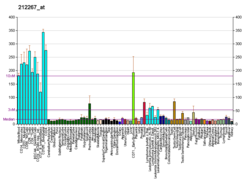Protein-coding gene in the species Homo sapiens
Wings apart-like protein homolog (WAPL) is a protein that in humans is encoded by the WAPAL gene. WAPL is a key regulator of the Cohesin complex which mediates sister chromatid cohesion, homologous recombination and DNA looping. Cohesin is formed of SMC3, SMC1, RAD21 and either SA1 or SA2. Cohesin has a ring-like arrangement and it is thought that it associates with the chromosome by entrapping it whether as a loop of DNA, a single strand or a pair of sister chromosomes. WAPL forms a complex with PDS5A or PDS5B and releases cohesin from DNA by opening the interface between SMC3 and RAD21.
Interphase

Cohesin loading begins in telophase and is mediated by NIPBL and its binding partner MAU2. In G1, WAPL forms a complex with PDS5 and removes cohesin from the DNA but it is reloaded by NIPBL-MAU2. The equilibrium between loading and release give cohesin a DNA residence time of 20 minutes. During DNA replication, a fraction of cohesin is acetylated and binds to Sororin making it resistant to WAPL and able to hold sister chromatids together. This is crucial for the maintenance of sister chromatid cohesion because once the sister chromatids are separated, cohesion cannot be reestablished.
Prophase pathway
When a cell enters mitosis, Sororin is phosphorylated causing it to dissociate from cohesin meaning WAPL can remove cohesin from the DNA. A complex of SGOL1 and PP2A dephosphorylates cohesin at the centromere protecting it from WAPL-mediated release. Sister chromatid cohesion is therefore maintained at the centromeres where it is required for mitosis but lost on the arms. This removal of cohesin is known as the Prophase Pathway and results in the X-shape sister chromatids observed in chromosome spreads.
Mechanism
WAPL releases cohesin from DNA by opening the SMC3-RAD21 interface thereby allowing DNA to pass out of the ring. Opening of this interface is regulated by ATP-binding by the SMC subunits. This causes the ATPase head domains to dimerise and deforms the coiled coil of SMC3 therefore disrupting the binding of RAD21 to the coiled coil. It is not known how WAPL regulates the process of ATP binding.
References
- ^ GRCh38: Ensembl release 89: ENSG00000062650 – Ensembl, May 2017
- ^ GRCm38: Ensembl release 89: ENSMUSG00000041408 – Ensembl, May 2017
- "Human PubMed Reference:". National Center for Biotechnology Information, U.S. National Library of Medicine.
- "Mouse PubMed Reference:". National Center for Biotechnology Information, U.S. National Library of Medicine.
- Nagase T, Seki N, Ishikawa K, Ohira M, Kawarabayasi Y, Ohara O, et al. (October 1996). "Prediction of the coding sequences of unidentified human genes. VI. The coding sequences of 80 new genes (KIAA0201-KIAA0280) deduced by analysis of cDNA clones from cell line KG-1 and brain". DNA Research. 3 (5): 321–9, 341–54. doi:10.1093/dnares/3.5.321. PMID 9039502.
- Gandhi R, Gillespie PJ, Hirano T (December 2006). "Human Wapl is a cohesin-binding protein that promotes sister-chromatid resolution in mitotic prophase". Current Biology. 16 (24): 2406–17. doi:10.1016/j.cub.2006.10.061. PMC 1850625. PMID 17112726.
- "Entrez Gene: WAPAL wings apart-like homolog (Drosophila)".
- Yatskevich S, Rhodes J, Nasmyth K (December 2019). "Organization of Chromosomal DNA by SMC Complexes". Annual Review of Genetics. 53: 445–482. doi:10.1146/annurev-genet-112618-043633. PMID 31577909.
- Beckouët F, Srinivasan M, Roig MB, Chan KL, Scheinost JC, Batty P, et al. (February 2016). "Releasing Activity Disengages Cohesin's Smc3/Scc1 Interface in a Process Blocked by Acetylation". Molecular Cell. 61 (4): 563–574. doi:10.1016/j.molcel.2016.01.026. PMC 4769318. PMID 26895425.
- Muir KW, Li Y, Weis F, Panne D (March 2020). "The structure of the cohesin ATPase elucidates the mechanism of SMC-kleisin ring opening". Nature Structural & Molecular Biology. 27 (3): 233–239. doi:10.1038/s41594-020-0379-7. PMC 7100847. PMID 32066964.
This article on a gene on human chromosome 10 is a stub. You can help Misplaced Pages by expanding it. |






